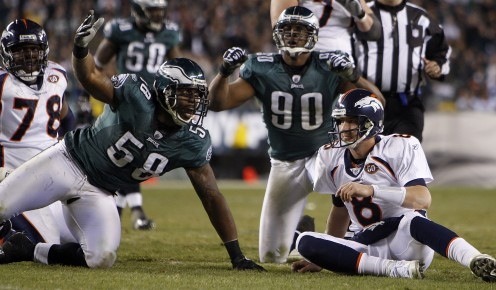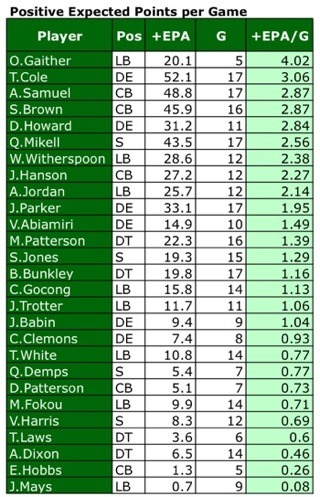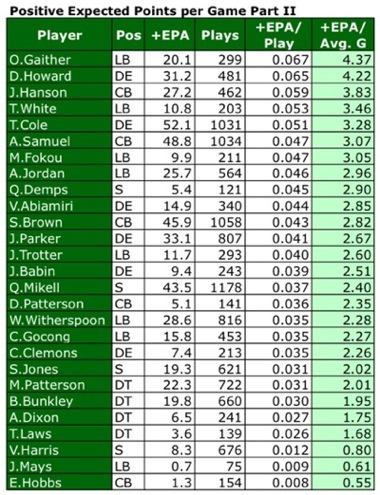
One of the keys to the 2010 Eagles season will be the performance of the defense. Last year the unit was, at best, inconsistent and this offseason we’ve seen a good deal of turnover. Sheldon Brown is gone. So is Darren Howard, Chris Clemons, Will Witherspoon, Sean Jones. Stewart Bradley returns, along with a whole host of draft picks and other new additions such as Darryl Tapp and Ernie Sims.
But it is often difficult to isolate individual player performance from team performance. How do we know whether the guys the Eagles jettisoned were truly underperforming? Hopefully this post will offer one possible way to gain some insight into that, simply by crossing two streams (oh no!) of data: one from Advanced NFL Stats and the other from Pro Football Focus.
Let’s start with Brian Burke’s Advanced NFL Stats measurement of +EPA as a measurement for defensive players. As he explains here, +EPA measures positive performance: “the value of every sack, interception, pass defense, forced fumble or recovery, and every tackle or assist that results in a setback for the offense.” What the stat doesn’t do is show you when the player did something wrong — when he cost the team. Thus, one would expect risk-taking players such as Asante Samuel to score disproportionately well in this system. His positive achievements regarding turnovers are huge, while his negative tackling ability never gets factored in.
Still, even with this caveat, it is an interesting way to look at players as playmakers. Here are the Eagles’ numbers from last year as put up by Burke, ordered by +EPA per the number of games they played in.

Obviously bland +EPA is of little use to determine who’s a better player. It’s far too dependent on the amount a player is on the field. At least Burke’s +EPA/G differentiates by number of games played to factor out some of the bias from players who played constantly and without injury. However, when I looked at this for the first time, I realized that games played was only a half step toward the greater goal of figuring out who caused the most postive plays, per play.
This is where Pro Football Reference’s play charting data — where they count how many times every player is on the field — comes in handy. Here’s for the Eagles. By looking at +EPA by play, rather than by game, you can get a much more “accurate” reading of playmakers. Below you can find the +EPA per time the player was on the field defensively (+EPA/Play), as well as a number that shows how much +EPA he would have accumulated had he played every defensive snap in the average Eagles’ game (~65).

Observations from this data (feel free to post your own in the comments):
- The fewer times a player was on the field, but active in the game, the more unreliable his numbers are going to be. Looking at you Tracy White and Quintin Demps.
- On the other hand, those who racked up huge play totals as well as +EPA/Avg. G (Trent Cole, Asante Samuel) clearly form the backbone of the playmaking contingent of the team.
- Darryl Tapp’s numbers with the Seahawks: 39.8 +EPA total, 704 plays, for a +EPA/Avg. G of 3.67 — placing him right near the top of the list.
- Ernie Sims’s from Detroit: 14.8 +EPA total, 490 plays, for a +EPA/Avg. G of 1.96 — positively Bunkley-ian.
- The scheme also affects opportunities for playmaking. For example, all four of the main defensive tackles fall in a row toward the bottom, indicating that the Eagles have been using the position less for playmaking, and more for solid building blocks of run defense. At the opposite end of the spectrum is Darren Howard, who often played as a DT in pass-rushing situations, giving him many more opportunities to make plays.
- But the fact that Howard was able to cause that pressure when he was in the game is important. While we can’t see some of the negative plays he may have allowed, Howard was clearly a better pass-rushing option than Chris Clemons, who made barely more +EPA per play than Mike Patterson. One has to wonder if Clemons for Tapp was a steal and/or if the Eagles will miss Howard’s rushing ability on third down.
- Other players who seemed to provide little in the area of playmaking: Macho Harris, Sean Jones, Chris Gocong, Will Witherspoon.
It’s worth mentioning one more time that this is far from the final answer at evaluating defensive performance. However, by combining +EPA with play counts, we gain one more interesting nugget for individual evaluation.